Something went wrong!
Hang in there while we get back on track
Best attractions in Veneto
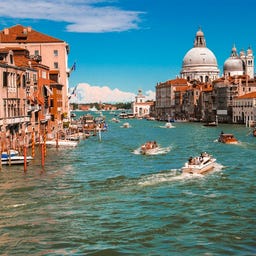
The Grand Canal is Venice's main artery, gracefully winding through the city in a large S-shape. The palaces along its banks, such as the Ca' d'Oro and the Palazzo Venier dei Leoni, are reminders of the Venetian Republic's former grandeur. Serving as the heart of Venice, the Grand Canal links many of the city's most significant landmarks.
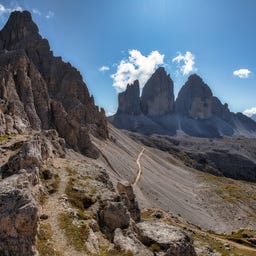
The Dolomites, a mountainous area in northern Italy, offer breathtaking panoramas with dramatic rock formations and challenging hiking trails. These impressive limestone peaks span a variety of valleys and summits, providing spectacular views, especially at sunrise and sunset when they glow in vibrant colors.
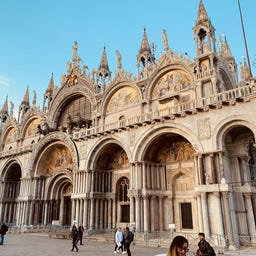
The basilica is a masterpiece of Byzantine architecture and Venice's top attraction. Known as the Church of Gold, it dazzles approximately 3 million visitors each year with over 8,000 square meters of golden mosaics and unique artworks depicting biblical scenes. A highlight is the magnificent Pala d'Oro, an altarpiece adorned with over 1,900 pearls and gemstones.
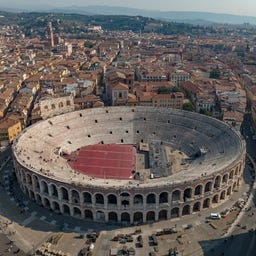
The Arena di Verona, one of the best-preserved Roman amphitheaters, draws thousands of visitors each year. Built in 30 AD, it stands majestically over Piazza Bra, impressing with its grandeur and the distinctive pink marble that takes on a magical glow in Verona’s soft light.
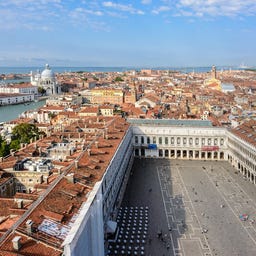
The Piazza San Marco is one of the most famous squares in the world - and rightly so. This grand piazza is surrounded by some of the most beautiful attractions of Venice, from the lavish St. Mark’s Basilica and towering Campanile to the Doge’s Palace.
As you step onto its expansive grounds, you’re walking the same stones that have hosted centuries of Venetian history, from grand processions to intimate café gatherings. Here, amid the cooing of pigeons and the distant serenade of a gondolier, you can truly feel the spirit of Venice.
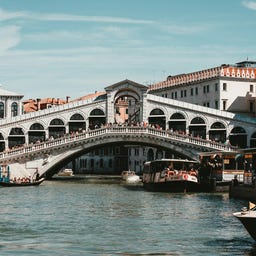
The Rialto Bridge, constructed in 1591, stands as one of Venice's most iconic landmarks. This magnificent stone bridge, adorned with elegant arches and intricate details, offers beautiful views of the Grand Canal. At the time of its construction, its bold architecture was considered so audacious that some architects predicted it would eventually collapse.

The Basilica of Saint Anthony in Padua is one of Northern Italy's most significant spiritual and architectural landmarks. Blending Romanesque, Gothic, and Byzantine elements, this extraordinary church captivates with its impressive facade and minaret-like bell towers.
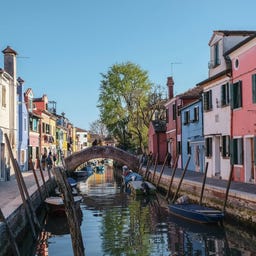
Murano is famous for its centuries-old glassmaking tradition. Visitors can watch the master glassblowers at work and admire unique artworks in numerous workshops. A visit to the Glass Museum is a must to learn about the history and production of Murano glass. Afterward, you'll view the souvenir pieces in the shops with newfound appreciation.

The Scrovegni Chapel in Padua is a must-see for art and history lovers. Located in the heart of Padua, in Piazza Eremitani, this masterpiece is famous for its Giotto frescoes, painted between 1303 and 1305. These stunning murals, depicting scenes from the Old and New Testaments, are considered a groundbreaking moment in art history. Highlights such as the Last Judgment and the Cielo Stellato make the chapel truly exceptional.
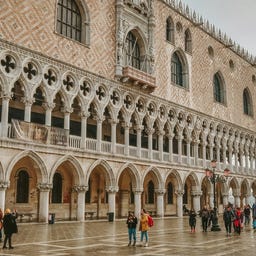
The Doge's Palace, a masterpiece of Venetian Gothic architecture built in 1340, served for centuries as the residence of the Doge and the center of political power in Venice. The palace's grandeur is evident in its magnificent halls, such as the Great Council Chamber, adorned with Tintoretto's "Il Paradiso," and the gold-encrusted Scala d'Oro, showcasing the Republic's former splendor.

At the Prato della Valle, you’ll find the largest square in Padua - an impressive ensemble featuring an artificial island surrounded by a water canal and adorned with 78 historical statues.
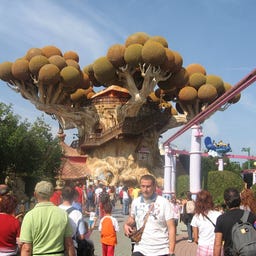
Gardaland, Italy's largest and most famous amusement park, is located on the southeastern shore of Lake Garda in Castelnuovo del Garda. The park offers an impressive variety of attractions, including adrenaline-pumping roller coasters, exciting water rides, and enchanting children's areas. A highlight for thrill-seekers is the Blue Tornado, a high-speed roller coaster featuring spectacular loops and twists.
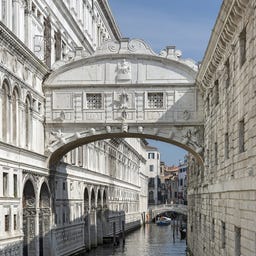
The Bridge of Sighs, an enclosed limestone bridge, connects the Doge’s Palace to the old prisons. Its name comes from the sighs of prisoners who caught their last glimpse of Venice through its small windows before facing their sentences. Many of its prisoners regularly drowned during high tide without ever seeing daylight again.
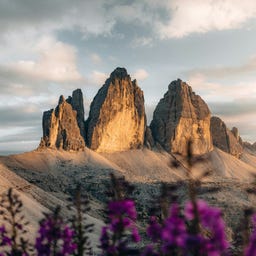
The three distinctive rock towers of the Tre Cime di Lavaredo are among the most famous peaks in the Dolomites and are considered significant climbing destinations in the Alps. Since their first ascent by Paul Grohmann in 1869, the peaks have attracted climbers from all over the world, while during World War I, they served as a frontline - remnants of trenches and barracks are still visible today.
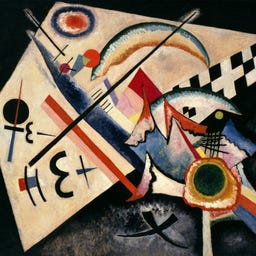
The Peggy Guggenheim Collection, situated in the Palazzo Venier dei Leoni on the Grand Canal, is one of Italy’s premier museums for 20th-century European and American art. The museum showcases Peggy Guggenheim's personal collection, featuring masterpieces by Jackson Pollock, Kadinsky, Max Ernst, and Pablo Picasso. A popular highlight of the visit is the Nasher Sculpture Garden, a serene oasis that invites visitors to pause and enjoy the art in a tranquil setting.
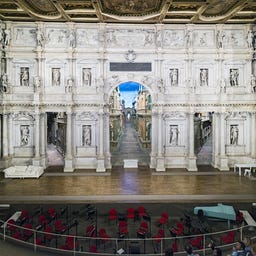
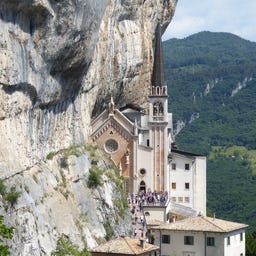
Nestled against the steep rock face of the Val d'Adige, the Santuario della Madonna della Corona rises majestically at an altitude of 775 meters, resembling an architectural marvel. Originally used as a hermitage in the 11th century, the site became a significant pilgrimage destination after the discovery of a Pietà statue in 1522.
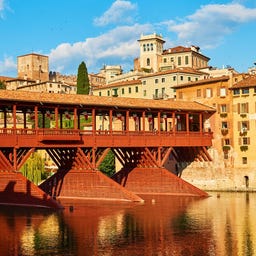
The Ponte degli Alpini in Bassano is one of the most famous covered wooden bridges in Italy, spanning the Brenta River since the 13th century. The current structure was designed by the renowned architect Andrea Palladio and features five elegant arches with Tuscan columns.
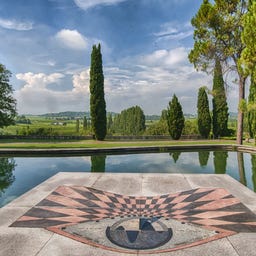
Just 8 km from Peschiera del Garda, you will find the 60-hectare Parco giardino Sigurtà - a historic garden that was named the most beautiful park in the world in 2023. What began in the 15th century as a walled garden, later welcoming guests like Emperor Franz Joseph I. and Napoleon III., now enchants visitors with a spectacular rose avenue featuring 30,000 plants and 18 dreamy ponds filled with water lilies and lotus flowers. In spring, the park transforms during the "Tulipanomania" into a sea of blossoms, attracting around 100,000 visitors each year and recognized as the second-largest tulip exhibition in Europe.
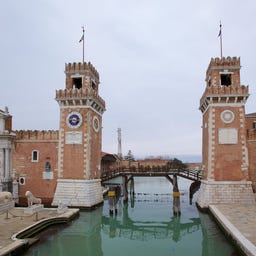
The Arsenale di Venezia, situated in the Castello district, is a quiet and often overlooked gem. Built in the 12th century, it was a vital shipyard and armory for the formidable Venetian navy, playing a crucial role in the city's maritime dominance.

Teatro La Fenice is one of the most prestigious and opulent opera houses in the world. Despite being devastated by fires in 1836 and 1996, it was meticulously rebuilt and reopened. Hence its namesake, The Phoenix.
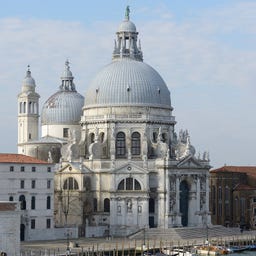
The Basilica di Santa Maria della Salute, located at the entrance to the Grand Canal, is a Baroque masterpiece built in 1630 as thanks for the end of a plague epidemic. Its impressive dome and the artistic mosaics inside captivate visitors. Notable artworks include Titian's "Marriage at Cana" and works by Tintoretto. The church is a symbolic landmark of Venice and should not be missed on any sightseeing tour.
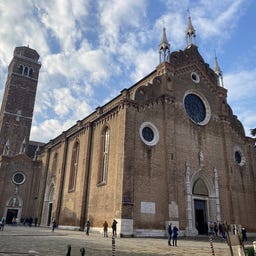
In the magnificent Basilica di Santa Maria Gloriosa dei Frari, Venice's second-largest church, you will find an impressive collection of Venetian art from the 13th to the 16th century. This Gothic-style brick building not only houses two masterpieces by the painter Titian, but also the tombs of significant figures like Claudio Monteverdi and Antonio Canova.
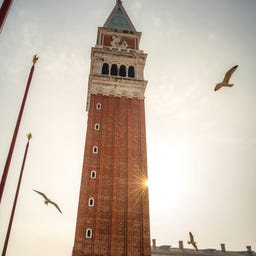
The 98.6-meter-high St. Mark's Campanile, originally built as a lighthouse, now offers stunning views of Venice and even the Alps on clear days. Constructed in the 12th century, the tower has been rebuilt several times, most recently after collapsing in 1902. For the best experience, visit early in the morning or late in the afternoon to avoid the crowds and capture great photos.
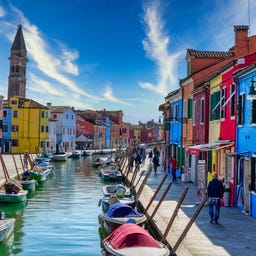
On the Venetian lagoon island of Burano, you will find a picturesque ensemble of colorful fishermen's houses, whose bright facades once served as a guide for returning sailors in the fog. The island, first mentioned in documents from the year 840, was founded by refugees from the Roman city of Altino, who fled from barbarian invasions.
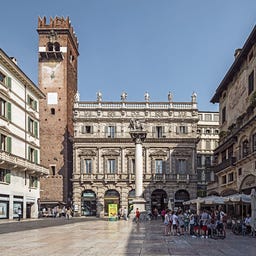
On the Piazza delle Erbe, Verona's oldest square, you can feel the city's history very intensely - this was once the site of the Roman Forum, the political and economic center of the ancient city. The magnificent square is lined with impressive buildings, including the baroque Palazzo Maffei with its statues of Greek gods and the Torre dei Lamberti.
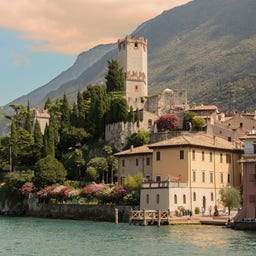
The "Scaliger Castle" in Malcesine is a hilltop castle in the eponymous Italian municipality on the eastern shore of Lake Garda in the province of Verona. The castle is known for Goethe's description in his "Italian Journey."

In the heart of Verona stands Castelvecchio, an impressive medieval fortress from the 14th century, built by Cangrande II della Scala between 1354 and 1356. Originally designed as a military structure, the castle now houses the Museo di Castelvecchio, which features a valuable collection of medieval and Renaissance art, including works by Pisanello, Bellini, and Rubens.
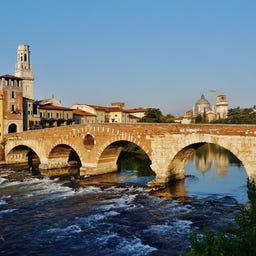
The Ponte Pietra over the Adige is Verona's oldest bridge and the only preserved Roman structure of its kind in the city. Originally built in 148 BC as a wooden construction, it was later replaced by an impressive stone bridge with five arches, two of which date back to Roman times.
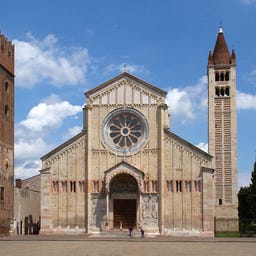
The Basilica di San Zeno Maggiore is one of the most significant masterpieces of Romanesque architecture and was built over the grave of Saint Zeno, who died in the 4th century. The basilica, in its current form, was mainly constructed between the late 11th and early 12th centuries, with its impressive tuff stone façade featuring a large rose window and a bronze portal adorned with 73 biblical reliefs being particularly striking.

The majestic Basilica Palladiana dominates the Piazza dei Signori in the heart of Vicenza and is one of the most significant buildings designed by the influential Renaissance architect Andrea Palladio, who transformed the original city palace between 1549 and 1614 with his characteristic white marble loggias.
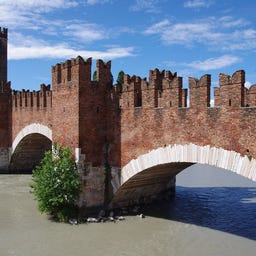
The impressive Ponte di Castelvecchio is one of the most remarkable structures of medieval Verona, built between 1354 and 1356 under Cangrande II della Scala as an escape route for the Castelvecchio fortress. With its main span of nearly 49 meters, this construction, also known as the "Scaligero Bridge," was one of the boldest bridge designs of its time in Europe.

As the highest peak of the Dolomites, the Marmolada majestically towers over the landscape at 3,343 meters and is home to the largest glacier in the region. During World War I, the mountain served as part of the Austro-Italian front, where Austrian troops created a fascinating tunnel system known as the "City of Ice" within the glacier.
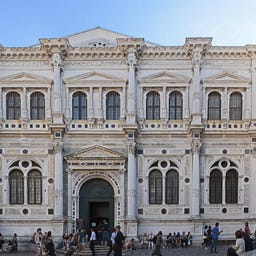
In the Scuola Grande di San Rocco, a brotherhood hall completed in the 16th century in the heart of Venice, you will find one of the most significant cycles of paintings in the city. The impressive halls house over 60 masterpieces by Tintoretto, whose artistic importance is often compared to that of the Sistine Chapel in Rome.
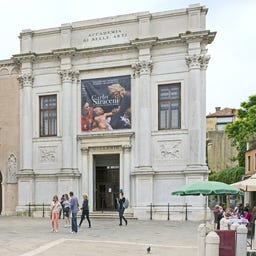
Gallerie Dell’ Accademia houses an impressive collection of Venetian art from the 14th to the 18th century, featuring works by Titian, Tintoretto, and Bellini. The museum’s carefully curated galleries offer a comprehensive look at Venice’s artistic evolution. Spend an afternoon here to deeply appreciate the grandeur of Venetian painting and sculpture.

In the historic center of Padua, you will find the Palazzo del Bo, which has been the main seat of one of the oldest universities in Europe since 1493. This impressive Renaissance building, named after an earlier tavern, houses the Teatro Anatomico, the oldest anatomical theater in the world.
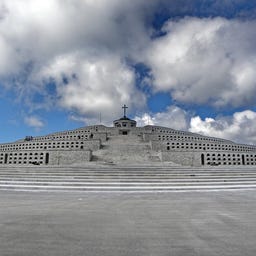
High up at 1,776 meters stands one of the most significant military ossuaries in Italy from World War I, designed by Giovanni Greppi and Giannino Castiglioni and inaugurated in 1935. On the semicircular terraces that follow the mountainside rest the remains of 22,910 Italian and Austro-Hungarian soldiers. The impressive memorial, which you can reach via the historic Cadorna Road, also features a chapel dedicated to the Madonna del Grappa and the Via Eroica—a 300-meter-long commemorative path marked with significant battlefields.
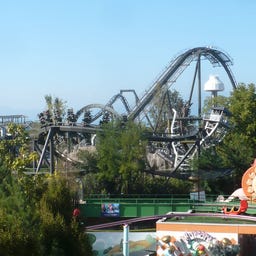
As the world's first wing coaster, the Raptor has been racing you through a post-apocalyptic sci-fi landscape at 90 km/h since 2011. This steel roller coaster from the Swiss company Bolliger & Mabillard impresses with its unique design, where the seats are mounted beside the tracks, giving you the sensation of flying freely through the air. On the 770-meter-long track, you can expect three inversions and a maximum height of 33 meters, all while you race through spectacular near-miss elements in just 90 seconds. The path to the coaster takes you through an atmospherically designed queue area into a semi-underground station, where the story of a mythical creature that is said to have awakened during the construction is told.

The Piazza dei Signori in the historic center of Padua is one of the city's most important squares, shaping public life since the 14th century. This rectangular square is lined with medieval and Renaissance buildings featuring characteristic arcades, dominated by the striking Torre dell'Orologio.
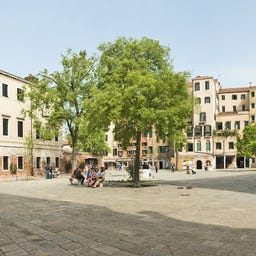
Founded in 1516, the Jewish ghetto in Venice was the first of its kind in Europe, symbolizing the enforced separation of the Jewish community from the rest of the city. The tall, densely packed buildings reflect the growing population that had to live within this confined space. Today, the ghetto is a vibrant center of Jewish culture. It boasts two synagogues, the Jewish Museum, and memorials dedicated to the victims of the Holocaust.
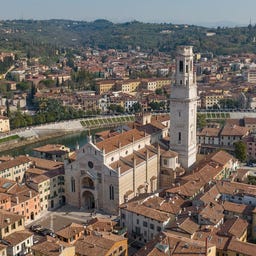
In the heart of Verona stands the Duomo di Verona, the impressive cathedral with a history dating back to the 4th century. The current structure, officially called Cattedrale di Santa Maria Assunta, was consecrated in 1187 by Pope Urban III. and combines Romanesque, Gothic, and Renaissance elements into a harmonious whole.
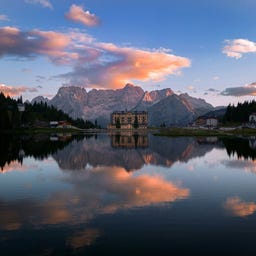
Lake Misurina, situated at an altitude of 1,754 meters, is the largest natural lake in the Cadore region of the Dolomites. Surrounded by the majestic Cadini di Misurina mountain range and about ten hotels, this 2.6-kilometer-long alpine lake offers unique natural experiences in both summer and winter.

In the Parco Natura Viva between Bussolengo and Pastrengo, you will find one of the most significant nature parks in Northern Italy, which has become an important center for species conservation since its founding in 1969 by Alberto Avesani and Giorgia Zaborra. The park combines a classic zoo with Northern Italy's first safari park, where you can observe the animals from your car.
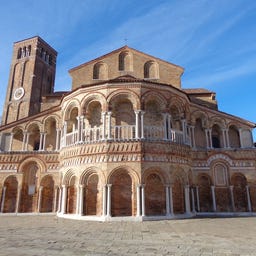
The Duomo di Murano impressively combines Romanesque and Byzantine architectural elements and has a rich history that dates back to the 7th century. In the magnificent basilica, originally dedicated to Santa Maria Assunta, you can find one of the most significant mosaic floors in Venice from 1141, as well as a splendid apse featuring the "Madonna Orante."
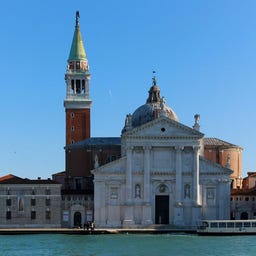
Majestically, the Basilica di San Giorgio Maggiore rises on its own island opposite St. Mark's Square, shaping the silhouette of Venice since the 16th century. This Renaissance building, constructed between 1566 and 1610 based on the designs of the famous architect Andrea Palladio, uniquely combines classical and cross-shaped floor plans.
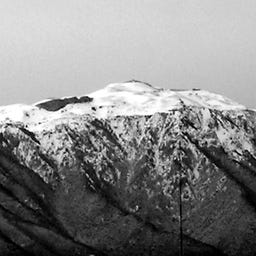
On Monte Grappa, you will find an impressive memorial from the 20th century that honors the fallen of World War I. The military shrine, designed by Giovanni Greppi, consists of five concentric rings that rise pyramid-like towards the Madonnina del Grappa chapel and houses the remains of over 12,000 soldiers.
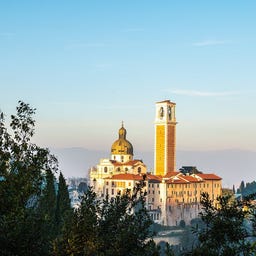
High above Vicenza stands the significant Marian shrine Santuario della Madonna di Monte Berico, which owes its origin to two apparitions of the Virgin Mary to the peasant Vincenza Pasini during a plague epidemic in the 15th century.
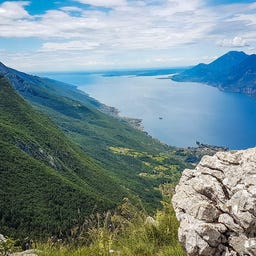
Monte Baldo, which stretches over 40 kilometers between Lake Garda and the Vallagarina Valley, is rightly known as the "Garden of Europe" - its unique plant life spans various climate zones up to an elevation of 2,218 meters. Here, you’ll find a diverse outdoor paradise that invites you to hike and ride in the summer, while in winter, the ski resorts of Prà Alpesina, Ortigaretta, and Polsa attract winter sports enthusiasts. The modern cable car from Malcesine takes you comfortably up high, where breathtaking views of Lake Garda await you, along with fascinating wildlife like chamois and marmots. On the mountain slopes, you can also visit the impressive Sanctuary of Madonna della Corona and take a break at several mountain huts, such as the Rifugio Gaetano Barana at 2,147 meters.
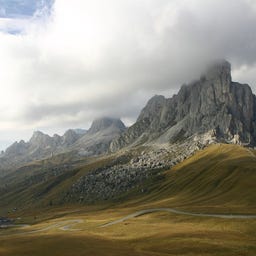
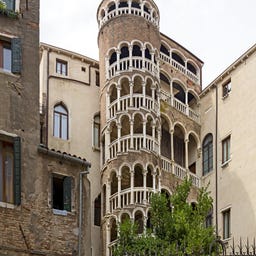
In the heart of the San Marco district stands the Palazzo Contarini del Bovolo, a fascinating example of Venetian late Gothic architecture from the 14th and 15th centuries. The architectural highlight of this former noble palace is its unique spiral staircase - called "bovolo" in the Venetian dialect - which gave the Contarini family their nickname.
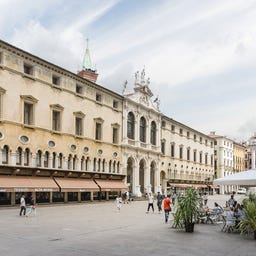
In the historic center of Vicenza, you will find the Piazza dei Signori, a former Roman forum that has become the vibrant heart of the city. The majestic Basilica Palladiana, a masterpiece by Andrea Palladio, dominates the square along with the 82-meter tall Torre Bissara, whose mechanical clock has been showing not only the time but also the phases of the moon since the 14th century.
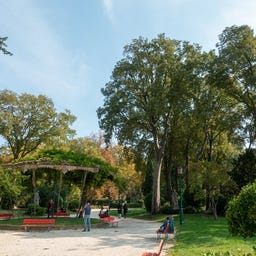
In the Giardini della Biennale, the largest green space in the historic center of Venice, you can expect a unique blend of park and art exhibition. Established in 1807 under Napoleon, the gardens became the venue for the world-famous Biennale in 1894 and have since housed an impressive collection of national art pavilions from the 20th century.
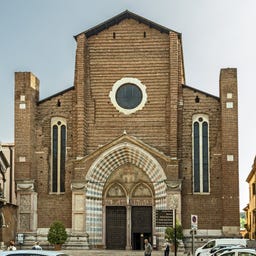
The largest church in Verona rises with its impressive Gothic facade near the Adige River in the historic center. Built by Dominican monks starting in 1290 and consecrated in 1471, the Chiesa di Sant'Anastasia captivates with its three-nave interior featuring powerful columns and numerous chapels.
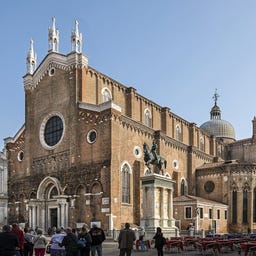
In the magnificent Gothic Basilica dei Santi Giovanni e Paolo, also known as the "Pantheon of Venice," you will find the tombs of numerous Venetian Doges and significant figures from the lagoon city. The basilica, whose construction began in the 13th century following a vision of Doge Jacopo Tiepolo and was completed only in 1430, impresses with its grand façade, a magnificent rose window, and a three-nave interior in the shape of a Latin cross.
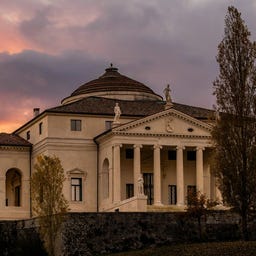
On a hill near Vicenza, you will find La Rotonda, one of the most influential villas in architectural history, which has been a UNESCO World Heritage Site since 1994. Designed by Andrea Palladio and completed by Vincenzo Scamozzi in 1605, the building impresses with its square layout and central dome, inspired by the Roman Pantheon.
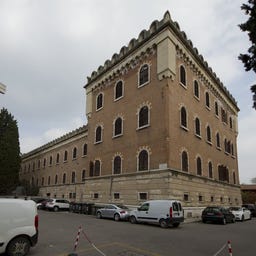
High above Verona stands the impressive Castel San Pietro, offering you one of the best panoramic views of the city. The history of the site dates back to pre-Roman times, but the current structure was built in the 1850s when the Austrians constructed a barracks in a neo-medieval style.
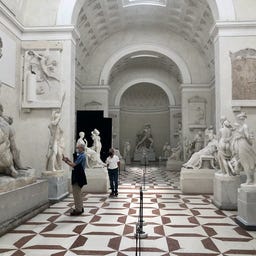
In the Gipsoteca canoviana, Europe's largest collection of plaster casts, you discover the impressive workshop of the renowned sculptor Antonio Canova. The museum complex, consisting of two buildings, was established in 1836 by Canova's half-brother to preserve the plaster models and clay sketches from the artist's Roman studio.
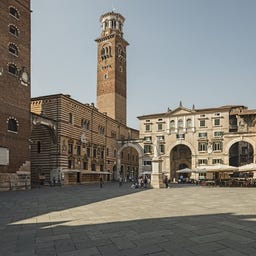
In the heart of Verona's historic center, you discover the Piazza dei Signori, an elegant square also known as Piazza Dante. Surrounded by medieval palaces connected by arcades and loggias, this place has been the political and administrative heart of the city since the Middle Ages.

In the oldest botanical garden in the world, the Orto botanico di Padova, you stroll through nearly 500 years of scientific history. Founded in 1545 as a medicinal plant garden and designated a UNESCO World Heritage site since 1997, the park is home to over 6,000 plant species, including the famous Palma di Goethe from 1585.

In the heart of Padua stands the majestic Palazzo della Ragione, whose history dates back to the 12th century and which once served as a courthouse and marketplace. This impressive building houses the "Salone" - one of the largest medieval halls in Europe, measuring an astonishing 80 by 27 meters and nearly 40 meters high.
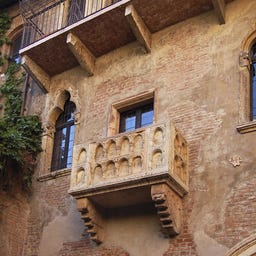
The Casa di Giulietta in Verona – the supposed home of literature’s most famous lovers – draws countless visitors each year. Originally built in the 13th century and once owned by the Cappello family, the medieval building was later linked to the fictional house of the Capulets from Shakespeare’s tragedy.

In the heart of Treviso, the Piazza dei Signori awaits you, the city's most important square, with a history dating back to the 12th century. This rectangular square, lined with tall arcades, is framed by three significant buildings: the Palazzo dei Trecento, the Palazzo del Podestà, and the Palazzo Pretorio.
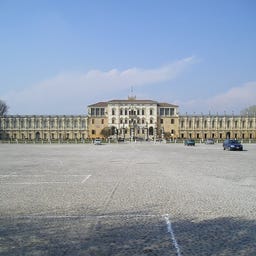
In the magnificent Villa Contarini, you will find one of the largest Venetian villas, whose core structure was likely designed by the famous architect Andrea Palladio in the 16th century. The 144 rooms of this baroque estate feature intricate frescoes and impressive halls, including the Galleria delle conchiglie, adorned with real shells, and a music hall with unique acoustics.
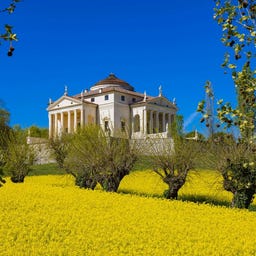
In the Veneto, you will find a unique group of country houses designed by the architect Andrea Palladio in the mid-16th century for Venetian noble families. These villas, which are now part of the UNESCO World Heritage, brilliantly combine beauty and functionality – with their characteristic wings, they served not only as representative residences but also as agricultural production sites.

In the heart of Padua, you will find the Caffè Pedrocchi, one of the most historic coffee houses in Italy, opened in 1831 by Francesco Pedrocchi and famously open day and night until 1916.
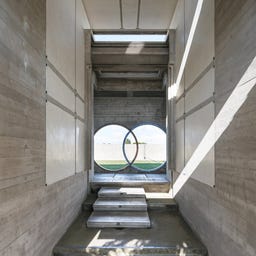
In the northern Italian province of Treviso, you can discover the Tomba Brion, one of the most significant works of modern tomb architecture. This monumental memorial complex, created by Carlo Scarpa from 1970 to 1978 for the Brion industrial family, uniquely combines modernist design with influences from Venetian and Far Eastern art.

The impressive Basilica di Santa Giustina is one of the largest sacred buildings in the world and majestically stands at Prato della Valle, the most significant square in Padua. This massive church, whose origins date back to before the year 1000, blends early Christian, Romanesque, Gothic, Renaissance, and Baroque elements into a stunning work of art.
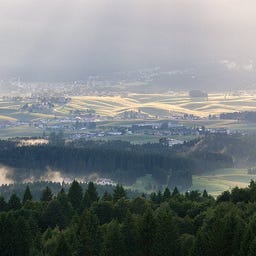
On the majestic Altopiano dei Sette Comuni, also known as the Altopiano di Asiago, you will find a fascinating high plateau in the Vicentine Prealps between the provinces of Vicenza and Trento. This area, once home to the Cimbri and organized as an independent federation until the 19th century, became a significant battleground during World War I—here, on May 24, 1915, the first Italian shot of the war was fired.
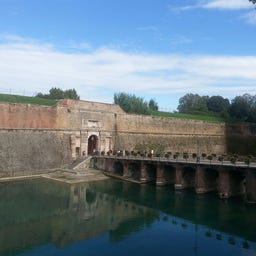
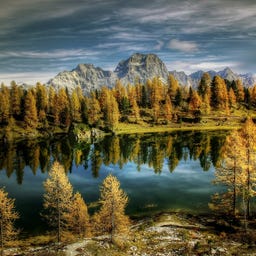
In the Dolomites southeast of Cortina d'Ampezzo, you will find the Lago di Sorapiss at an altitude of 1,925 meters, a mountain lake with its characteristic turquoise water, surrounded by impressive rock walls. The hike to the lake can be done via well-marked trails - either in about two hours along path 215 from Passo Tre Croci or alternatively via the three-hour route 213.
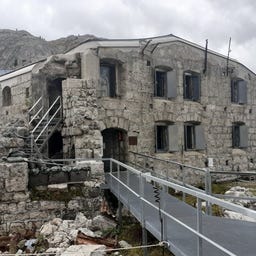
High up at the Valparola Pass between South Tyrol and the Dolomites stands the Forte Tre Sassi, a former Austrian border fortification from the early 20th century. Completed in 1901, the fortress was heavily damaged by shelling in 1915, leading to its abandonment.
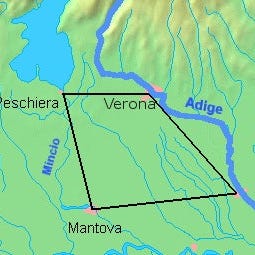
Between the rivers Mincio, Po, and Adige, you will find the Quadrilatero, one of the most heavily fortified defense systems of the 19th century in Europe. The four powerful fortresses in Peschiera del Garda, Mantova, Legnago, and Verona were built by the Austrian Empire between 1815 and 1866 and connected by the Milan-Venice railway line. After the experiences of the Second Italian War of Independence in 1859, the system was expanded with a second outer defensive ring, with Verona developed into a central maneuver and supply depot.
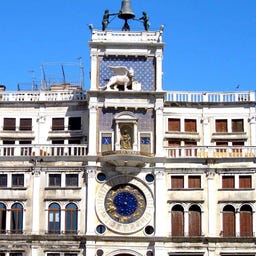
The Torre dell'Orologio at the northwest end of Piazza San Marco is one of the most impressive timepieces of the Renaissance: Since 1499, its grand clock has not only shown the time but also the phases of the moon and zodiac signs. The 24-meter-high tower clock is topped by two bronze "Mori" figures that strike the hours on a large bell—one two minutes before and the other two minutes after the hour. Through its majestic archway, which connects Piazza San Marco with the Merceria, one of Venice's most important passages leads you. On Epiphany and Ascension Day, you can witness a special spectacle here when mechanical figures of the Three Wise Men perform their procession.
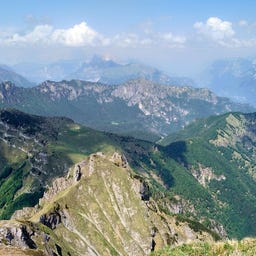
In the Parco Nazionale Dolomiti Bellunesi, which has been a UNESCO World Heritage site since 2009, you can expect an impressive natural landscape spanning over 31,500 hectares.
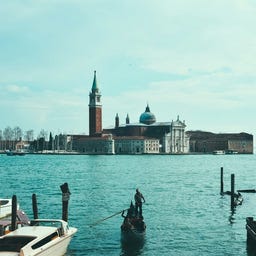
Directly opposite the famous St. Mark's Square, the small island of San Giorgio Maggiore rises, which already housed an early wooden church in the 8th/9th century. The current Basilica of San Giorgio Maggiore, a masterpiece by architect Andrea Palladio, significantly shapes the silhouette of Venice.

The Porta Borsari, one of the best-preserved Roman city gates in Verona, greets you with its impressive 13-meter-high facade made of white Valpantena stone. Built in the 1st century BC, this structure served as the main entrance to the Roman city and marked the route of the important Via Postumia.
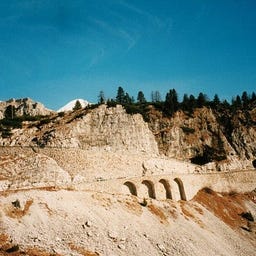
At an altitude of 2,117 meters, the Passo di Falzarego serves as an important Dolomite pass connecting the Agordino area with Cortina d'Ampezzo. From the pass station, a cable car takes you to the Lagazuoi refuge, while cyclists can tackle the challenging 15-kilometer ascent from both sides.
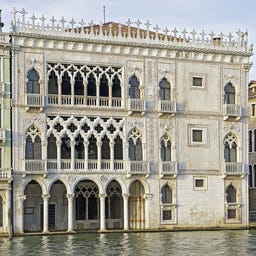
The Ca' d'Oro on the Grand Canal is one of the most magnificent examples of Venetian Gothic architecture, with its gold-adorned facade giving the palace its name. This impressive building was constructed in the 15th century by the Doge family Contarini and captivates with its asymmetrical facade featuring five large arches on the ground floor and ornate loggias on the upper levels.
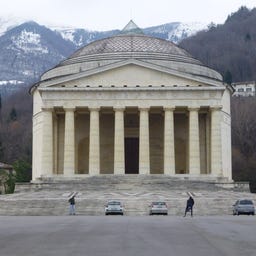
High above the Italian village of Possagno stands the Tempio Canoviano, an impressive church in neoclassical style that combines elements of the Pantheon and the Parthenon. The famous sculptor Antonio Canova fully financed its construction out of his own pocket in the early 19th century when the old village church became dilapidated.
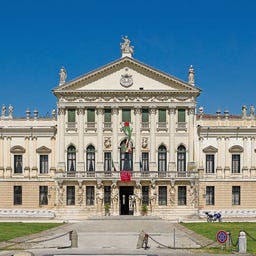
With 168 rooms and a 14-hectare park, the Villa Pisani is one of the most impressive villas on the Venetian Riviera del Brenta. This magnificent estate, built starting in 1721 for the noble Pisani family, has hosted illustrious guests throughout its history, including Napoleon and members of the Habsburg family.

In the picturesque Colli Euganei, you will find the impressive Castello del Catajo, a blend of military fortress and princely villa from the 16th century. This monumental building, which has 350 rooms and was started by Pio Enea I Obizzi and later expanded by the Habsburgs into a ducal residence, features significant frescoes by Giovanni Battista Zelotti that tell the story of the Obizzi family.
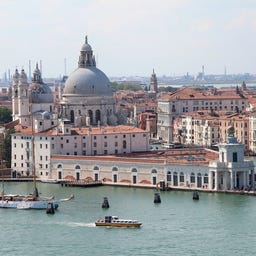
At the prominent point between the Canal Grande and the Giudecca Canal stands the historic Dogana da Mar, Venice's former customs house from the 17th century. The triangular building is topped by a distinctive tower, where two Atlas figures hold a golden globe.
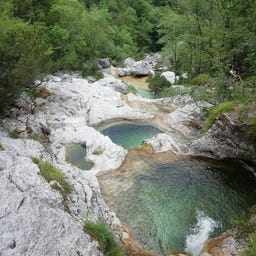
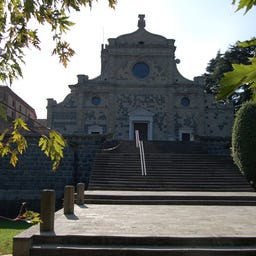
In the picturesque landscape near Padua stands the Abbazia di Praglia, an active Benedictine monastery that was founded in 1080 by the Maltraverso family. The impressive complex, which was completely rebuilt in the 15th century, captivates with its four distinctive cloisters, including a botanical cloister and a "floating" cloister with a large cistern.
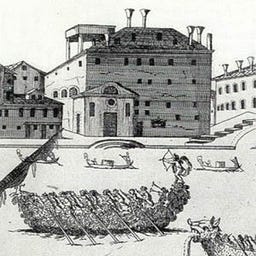
The Pio Ospedale della Pietà is one of Venice's most remarkable historical institutions, serving as an orphanage, convent, and conservatory since the 14th century. Here, famous composers like Antonio Vivaldi and Francesco Gasparini taught the "Daughters of the Choir" - young orphan girls who became known for their sacred music performances.
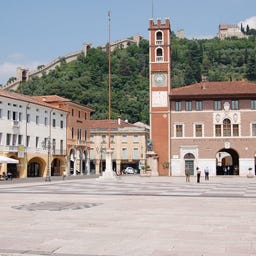
On the Piazza degli Scacchi in Marostica, you will find an impressive medieval square featuring a distinctive chessboard pattern, framed by long arcades and two castles from the 14th century.
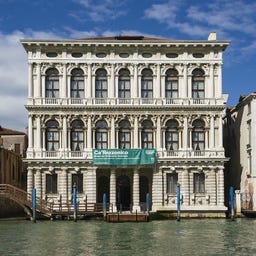
In the magnificent Ca' Rezzonico on the Canal Grande, you experience 18th-century Venetian culture in an authentic palace setting. Originally designed by Baldassarre Longhena in 1649, the Baroque palace was completed in 1758 by the wealthy Rezzonico family and now houses the Museum of 18th Century Venice.

In the Veneto Regional Park of the Po Delta, the largest wetland in Italy, you can expect a unique natural landscape of lagoons, fossil dunes, and expansive valleys. Recognized as a UNESCO Biosphere Reserve since 2015, this area spans 12,000 hectares and is almost entirely below sea level.

In the northern Italian Parco delle cascate di Molina, you can experience a fascinating natural spectacle of waterfalls that have carved their way through the rocks over millions of years. On three well-marked hiking trails - from the 30-minute Green Path to the two-hour Black Path - you will discover twelve different waterfalls, such as the prehistoric waterfall and the impressive Bear Waterfall.

At 3,152 meters, the Piz Boè stands as the highest peak of the Sellagruppe in the Dolomites, rising at the border of the provinces of Belluno, Bozen, and Trient. Since its first ascent by Paul Grohmann in 1864, the mountain has become a popular hiking destination, accessible via various trails.

The impressive Palazzo Maffei has been standing since the 17th century at the northern end of the Piazza Erbe, where the Roman Capitol once was. The magnificent Baroque facade is topped with six statues of gods and captivates with its three-story structure, complete with an elegant colonnade on the ground floor.
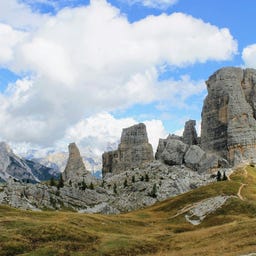
The striking rock formation of the Cinque Torri consists of five distinctive towers made of light dolomite, with the highest tower, the Torre Grande, reaching 2,361 meters. Here, you’ll find a fascinating outdoor paradise that offers climbing routes of various difficulty levels, well-maintained hiking trails, and top-notch ski slopes in winter as part of the Dolomiti Superski area. The region was heavily contested during World War I - today, you can explore the restored military installations along historical trails. Two mountain huts, the Rifugio Cinque Torri and the Rifugio Scoiattoli, provide hikers and climbers with an ideal starting point for their adventures in this impressive part of the Dolomites.
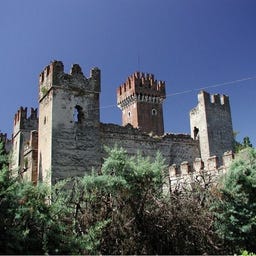
The mighty Castello Scaligero has overlooked the northern Italian town of Lazise since the 9th century, bearing witness to a tumultuous history of defense around Lake Garda. With its six defensive towers, the central keep, and two entrances secured by drawbridges, the structure was particularly expanded to its impressive form under the rulers della Scala in the 14th century.

Overlooking the Canal Grande, the Palazzo Grassi represents the last grand palace residence of the Venetian Republic from the 18th century. Originally built for the Grassi family, this magnificent structure changed hands several times before being acquired by François Pinault in 2005. Today, the palace, with its neoclassical facade made of Istrian stone, houses one of the most significant collections of contemporary art in the world, featuring works by artists like Mark Rothko and Andy Warhol. The impressive main staircase adorned with frescoes by Michelangelo Morlaiter still reflects the original splendor of the building, while the modernized interiors now serve as exhibition space for rotating art shows.

In the Chiesa di San Pantalon, you'll find one of the most impressive ceiling paintings in Venice - a massive 443 square meter work by Giovanni Antonio Fumiani, created not as a fresco but on canvas. The church, first mentioned in the 12th century, was extensively renovated between 1668 and 1704 and houses significant artworks, including the last painting by Paolo Veronese from 1587.

In the restored cloisters of the former Eremitani Monastery, you will find the Musei Civici, a fascinating museum complex that brings together art and history from antiquity to the 19th century. The centerpiece is the Museum of Medieval and Modern Art, featuring around 3,000 paintings by renowned masters like Giorgione, Titian, and Tintoretto.
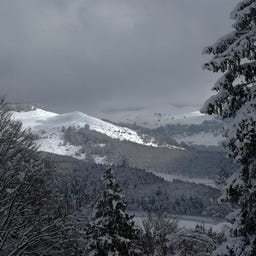
In the Lessinia Regional Natural Park, one of the largest grazing areas in the Italian Alps, you can explore a unique karst landscape spanning over 10,000 hectares at altitudes between 1,200 and 1,800 meters.
